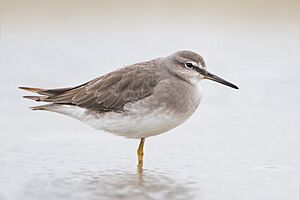Limmen Bight facts for kids

Limmen Bight is a big, open bay in the Northern Territory of Australia. It's found at the western end of the Gulf of Carpentaria. This special place is about 360 kilometers (224 miles) east of Katherine.
The Marra people have lived on and used these lands and waters for a very long time. The bight was named in April 1644 by Abel Tasman. He named it after one of his ships during his journey exploring the northern Australian coast. Limmen Bight has the second largest area of tidal flats in the Northern Territory.
Contents
Exploring Limmen Bight's Geography
Limmen Bight has several small islands off its coast. The biggest island is Maria Island. Other islands include Edward, Sandy, and Beatrice Islands, plus Low Rock.
The bight is bordered by different areas. To the southwest, you'll find the Gulf Plains of the Northern Territory. To the northwest, it meets the southeastern coast of Arnhem Land. To the north, it's near Groote Eylandt.
Rivers and Land Around the Bight
The Roper River flows into the bight at its westernmost point. Other rivers that empty into Limmen Bight are the Rose, Towns, and Limmen Bight Rivers.
Most of the land around the bight belongs to Aboriginal people. It is held by the Arnhem Land and Marra Aboriginal Land Trusts. Some parts are also within Nathan River and other pastoral leases (land rented for farming animals). Port Roper, located at the mouth of the Roper River, is a place where people set up temporary fishing camps.
Amazing Animals of Limmen Bight
The beaches on the bight's islands are very important. Many terns come here to build their nests. It's also a nationally important spot for marine turtles to lay their eggs.
Birds and Marine Life
The huge coastal mudflats are a feeding ground for over 30,000 migratory waders, also known as shorebirds. The freshwater swamps on the river floodplains are home to tens of thousands of waterbirds. The coastal waters also have many dugongs, which are gentle sea mammals.
Threatened Species in the Area
Some rare and threatened vertebrate species live in Limmen Bight. These include the Australian bustard, masked owl, partridge pigeon, and northern hopping mouse. You can also find several types of turtles here: the flatback, green, hawksbill, and olive ridley turtles.
Limmen Bight: An Important Bird Area
BirdLife International has named a large area of 2,234 square kilometers (863 square miles) along the coast of Limmen Bight an Important Bird Area (IBA). This means it's a very special place for birds.
Why is it an Important Bird Area?
This area is important because it supports more than 1% of the world's population of certain birds. These include grey-tailed tattlers, great knots, and white-headed stilts. The IBA stretches along the coastline from the Roper River to the Limmen Bight River. It also includes the swamps south of and along the lower Roper River.
The main habitats here are muddy areas that are covered and uncovered by tides. There are also low areas with samphire shrubland, small patches of dry rainforest, and mangroves along the river channels.
Special Birds of the IBA
Chestnut rails live in the mangroves of the IBA. Many black-tailed godwits have also been seen here. Near the Roper River mouth, there's a waterbird breeding colony with about 2,500 birds. This includes pied herons, egrets, and cormorants.
The site also has large groups of seabirds that come to breed. It's home to the biggest pied cormorant and little tern colonies in the Northern Territory. There are also colonies of up to 10,000 crested terns and 5,000 roseate terns. Sandy Island and Low Rock form another separate IBA that is important for nesting terns.

